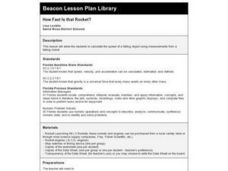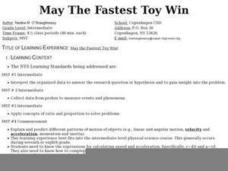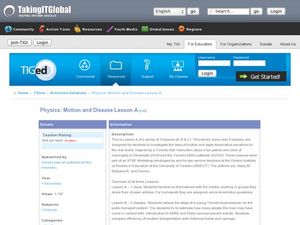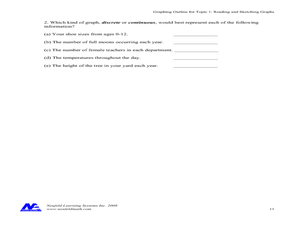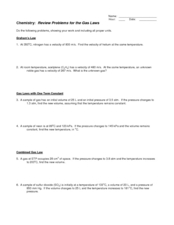Flipped Math
Calculus AB/BC Unit 4 Review: Analytical Applications of Differentiation
It's nice to know that there are actual real-world uses of derivatives. Scholars review their knowledge of the applications of derivatives from the unit. They work on a set of practice problems to test their understanding.
Flipped Math
Calculus AB/BC Unit 5 Review: Analytical Applications of Differentiation
Time to put it all together in one sheet—well five. Pupils review all the topics presented in the resources for Analytical Applications of Differentiation. The five pages summarize the concepts with explanations and examples.
Curated OER
Go Car, Go!
Learners design and build their own car. In this physics instructional activity, students collect data to determine the speed of the car. They plot the data on the graph analyze the relationship between variables.
Curated OER
What is Momentum?
In this momentum learning exercise, students will calculate the maximum forward momentum of the Apollo 11 lunar spacecraft at three different stages of its space travel.
Curated OER
Falling into a Black Hole
In this black hole worksheet, students solve 3 problems given the equation used to determine the speed of a falling body using its mass, the constant of gravitation and the distance it will travel.
Curated OER
Kinetic Energy and Work
Students study kinetic energy and how it works. In this investigative lesson students divide into groups and attempt to break a board with their hand.
Curated OER
How Fast Is that Rocket?
Eighth graders calculate the speed of a falling object using measurements from a falling rocket. They report data from their data sheet to the teacher to record on the board or on the overhead transparency and discuss the results with...
Curated OER
May The Fastest Toy Win
Students determine which wind-up toy is the fastest. However, they can NOT race the toys. They must find another way. On the first day of the activity, students work in pairs or small groups to develop and write a plan.
Curated OER
The Sounds of Summer
Young scholars experiment with measuring the speed of sound in an open field by clapping hands and measuring the time delay between the clap and hearing the sound at a long distance. Students practice solving equations at completion of...
Curated OER
Motion
In this motion activity, students complete graphs showing speed vs. time and acceleration vs. time. This activity has 2 graphs to complete.
Curated OER
Momentum of Line in Art
In this momentum worksheet, students read about how artists use the term momentum to describe how a viewer's eyes move a long a line. Then students complete 4 short answer questions.
Curated OER
Pedestrian Safety
Students study velocity and how to cross streets safely. They identify the ten most common causes of childhood trauma, watch movies on pedestrian safety and use the Internet to research the issue of pedestrian safety
Curated OER
Conducting a Scientific Investigation
In this scientific investigation worksheet, young scholars answer 16 questions about conducting a scientific experiment on marble's and their velocity at different ramp heights. Students write a scientific question and then go through...
Curated OER
Physics: Motion and Disease
High schoolers read media and identify examples of science technology and society. In this physics lesson, students learn about acceleration and velocity. High schoolers estimate how many people would have come in contact with a...
Curated OER
Slinky Movement Lab
In this wave worksheet, students use Slinky's to observe the properties of waves. They observe longitudinal waves, transverse waves, traveling waves and standing waves and record their observations. They calculate the frequency and...
Curated OER
Reading and Sketching Graphs
In this graphs worksheet, students answer 15 multistep questions about graphs. Students determine distance traveled, time, velocity, and create scenarios to fit the graph.
Curated OER
IPC Physics Final Review
For this physics review worksheet, high schoolers compare experimental variable, simple machines, and Newton's Laws. Students calculate kinetic energy, work, power, speed, and velocity. High schoolers review conduction, convection, and...
Curated OER
Gases Worksheet
In this gases worksheet, students solve twenty problems using the gas laws and their understanding of the relationship between energy and temperature and energy and velocity.
Curated OER
Equations with one Variable II
In this single variable equations instructional activity, high schoolers solve 5 problems using different equations to solve for one unknown. They use Hubble's Law to find the velocity of a galaxy knowing the distance it travels.
Curated OER
Reviewing Problems for the Gas Laws
In this gases worksheet, students apply gas laws to calculate the change in pressure or temperature depending on what has occurred to the gas. This worksheet has 11 problems to solve.
Curated OER
Mass & Velocity Effect
Students, after reading the explanation given below, use FoilSim to complete the activity to fulfill the specifications of a given airfoil and then plot and interpret graphs.
Curated OER
Pendulum Motion Experiments
Students experiment with simple pendulums to determine the validity of an equation for all angles. Students discover the usefulnes and limitations of approximations in science. Using spreadhseets and a java applet, students observe the...
Curated OER
Building the Car (Mechanics and Motion)
Students design and begin building a car out of K'NEX parts after a class discussion on the components of the car, the constraints and goals of the design, the type of testing that will be performed, and a demonstration of a basic...
Curated OER
Science Word Search
In this science worksheet, students identify and locate various science related vocabulary terms. There are 21 words located in the puzzle.
Other popular searches
- Speed Velocity Acceleration
- Constant Velocity
- Velocity and Acceleration
- Average Velocity
- Speed and Velocity
- Angular Velocity
- Average Speed and Velocity
- Relative Velocity
- Speed & Velocity
- Terminal Velocity
- Escape Velocity
- High Velocity Impacts






